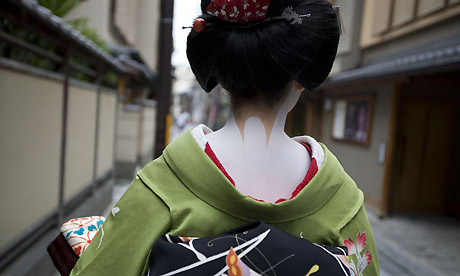Renewed respect as geisha make a comeback – and take to cyberspace
Teenage girls are flocking to enter ‘floating world’ in return to traditional culture

Kyoto geisha girls. Photograph: Jeremy Sutton-Hibbert
Miehina has barely taken a dozen steps along a Kyoto street before the audio backdrop to her every public move comes to life. In the fading light of an early summer evening, the metronomic clip-clop of her platform okobo sandals is accompanied by the clicking of shutters, as a gaggle of amateur photographers seeks the perfect snapshot of one of Japan’s most venerated women.
They stay with her until she retreats down a backstreet and slips through the sliding wooden door of her teahouse, her emerald green kimono, worth tens of thousands of pounds, now no more than a photogenic imprint.
In the past tourists would have had to wait hours for a fleeting glimpse of a lone geisha on her way to an appointment. Now they are spoiled for choice.
After decades of decline, Japan’s traditional entertainers are making a comeback. Earlier this year the number of geisha trainees – known as maiko – reached 100 in Kyoto for the first time in four decades.
Much of the mild embarrassment many Japanese felt about the geisha thread running through their cultural fabric arose from popular misconceptions: the suspicion that, beneath the veneer of cultural exclusivity, they were little more than high-class prostitutes.
Experts believe the recent surge in teenage girls hoping to enter the “floating world” of tea ceremonies, performing arts, and yes, flirtatious exchanges with inebriated clients, is evidence of renewed respect among the Japanese for their traditional culture.
